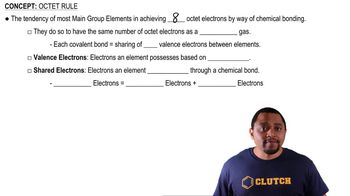(a) Describe the molecule xenon trioxide, XeO3, using four possible Lewis structures, one each with zero, one, two, or three Xe¬O double bonds. (b) Do any of these resonance structures satisfy the octet rule for every atom in the molecule? (c) Do any of the four Lewis structures have multiple resonance structures? If so, how many resonance structures do you find? (d) Which of the Lewis structures in part (a) yields the most favorable formal charges for the molecule?
Ch.8 - Basic Concepts of Chemical Bonding
Chapter 8, Problem 70b
Some chemists believe that satisfaction of the octet rule should be the top criterion for choosing the dominant Lewis structure of a molecule or ion. Other chemists believe that achieving the best formal charges should be the top criterion. Consider the dihydrogen phosphate ion, H2PO4-, in which the H atoms are bonded to O atoms. (b) What is the predicted dominant Lewis structure if achieving the best formal charges is the top criterion?
 Verified step by step guidance
Verified step by step guidance1
Identify the total number of valence electrons in the dihydrogen phosphate ion (H2PO4-). Phosphorus (P) has 5 valence electrons, each oxygen (O) has 6, and each hydrogen (H) has 1. Additionally, add 1 electron for the negative charge.
Arrange the atoms with phosphorus as the central atom, and attach the oxygen atoms and hydrogen atoms to the oxygens. Remember that hydrogen can only form one bond.
Distribute the electrons to satisfy the octet rule for the central phosphorus and the oxygen atoms, while ensuring that each hydrogen atom is connected to an oxygen atom with a single bond.
Calculate the formal charges for each atom. The formal charge is calculated using the formula: Formal Charge = (Valence electrons) - (Non-bonding electrons) - 0.5*(Bonding electrons).
Choose the structure that minimizes the formal charges on each atom, aiming for a structure where the sum of the formal charges equals the overall charge of the ion, which is -1 in this case.

Verified video answer for a similar problem:
This video solution was recommended by our tutors as helpful for the problem above.
Video duration:
5mWas this helpful?
Key Concepts
Here are the essential concepts you must grasp in order to answer the question correctly.
Octet Rule
The octet rule is a chemical guideline stating that atoms tend to bond in such a way that they each have eight electrons in their valence shell, achieving a stable electron configuration similar to that of noble gases. This rule helps predict the arrangement of electrons in molecules and is crucial for understanding molecular stability and reactivity.
Recommended video:
Guided course

Octet Rule
Formal Charge
Formal charge is a theoretical charge assigned to an atom in a molecule, calculated by taking the number of valence electrons, subtracting the number of non-bonding electrons, and half the number of bonding electrons. It helps chemists determine the most stable Lewis structure by minimizing formal charges across the molecule, leading to a more favorable electron distribution.
Recommended video:
Guided course

Formal Charge
Lewis Structures
Lewis structures are diagrams that represent the bonding between atoms in a molecule and the lone pairs of electrons that may exist. They are essential for visualizing molecular geometry and electron distribution, allowing chemists to predict the behavior of molecules in chemical reactions and their interactions with other substances.
Recommended video:
Guided course

Lewis Dot Structures: Ions
Related Practice
Textbook Question
Textbook Question
There are many Lewis structures you could draw for sulfuric acid, H2SO4 (each H is bonded to an O). (a) What Lewis structure(s) would you draw to satisfy the octet rule?
Textbook Question
There are many Lewis structures you could draw for sulfuric acid, H2SO4 (each H is bonded to an O). (b) What Lewis structure(s) would you draw to minimize formal charge?
Textbook Question
State whether each of these statements is true or false. e. Energy is stored in chemical bonds.
